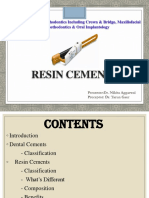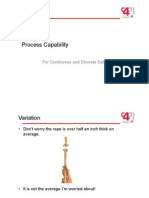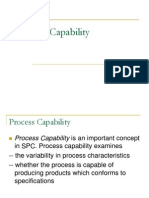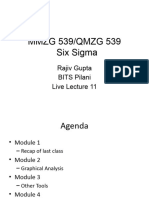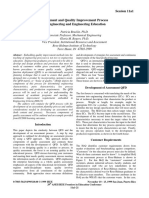Process Capability: 99.73% of parts lie within the 6 σ limits
Uploaded by
rm_muruganProcess Capability: 99.73% of parts lie within the 6 σ limits
Uploaded by
rm_muruganNotes on Process Capability
Professor Graeme Britton, 2000
Process Capability
These notes are a brief introduction to process capability. For further information refer to Bothe in the
bibliography.
In order to carry out process planning a process planner must be able to predict how manufacturing
processes will perform. This is achieved by measuring the process capability of the processes. Before the
capability of a process can be measured the process must be stable. In other words, prediction of future
performance is not possible without a stable process. The performance of a process can be measured using
the dimensions of parts produced by the process. Parts made by the process will vary slightly in size, i.e., in
the values of the dimensions. The frequency distribution of the values will form a statistical distribution, a
normal distribution, Figure 1. A process is stable if the parameters of the statistical distribution dont
change, i.e., the mean and variance are constant, Figure 2.
99.73% of parts lie within the 6 limits
(6)
Number of
parts of a
specified size
large part
small part
Size of parts, e.g., shaft diameter
Figure 1.: Variables Measurement of Process Performance
constant mean and variance
Past
Future
Present
Figure 2.: Prediction Requires Constant Process Parameters
Notes on Process Capability
Professor Graeme Britton, 2000
Control charts are used to ensure that a process is statistically stable. Two main types of control charts are
used for variables measurement: X bar chart and R (or s) chart. The X bar chart controls the process mean
and the R chart controls the variance. Control charts are based on sampling distributions. They plot and
track the statistics of samples of parts, not individual parts. The X bar tracks the sample means and the R
chart the sample ranges, Figure 3.
X
Chart
averages
upper control limit
lower control limit
Range
Chart
ranges
upper control limit
lower control limit
Figure 3.: Variables Control Charts
Control limits are placed on the charts. Samples are taken at regular intervals and plotted on the charts.
Provided the sample values fall within the control limits no action is taken. If a sample value falls outside
the limits, action is taken to find out why and to rectify the situation, if necessary. A process is said to be in
a state of control if there at least 25 sub-groups (points) between out-of-control conditions. This condition is
necessary but not sufficient to define process stability. In addition, the points between control limits must be
random, due solely to common causes of variation. Non-random patterns are:
runs: 7 or more consecutive points on one side of the chart centreline,
trends: 7 or more points move consecutively up or down,
cycles: repeated patterns,
hugging the centreline: 12 consecutive points lying in the middle third of the control chart,
hugging the control limits: a large number of points near the control limits and very few near the
centreline.
Control charts are used to ensure process stability rather than inspection based on individual parts, because
they are more sensitive to changes in process parameters, Figure 4. In this example, the process mean
moves an amount equal to 6. If inspection is used there is only a 50% change of detecting this very large
shift in process mean. On the other hand, if a control chart is used there is a 99.865% change of detecting
the change.
Notes on Process Capability
Professor Graeme Britton, 2000
X
LSL
=0
=2 USL LSL
+6
-6
X=0
X=1
X
LCL
=6
=2 USL
+6
-6
99.865%
6 shift in mean
UCL
-3 X=0 +3
50%
X=6
LCL
-3
UCL
X=1
+3 X=6
Figure 4.: Control Charts Better at Detecting Change Than 100% Inspection
(Reproduced from Bothe 1997)
The power of control charts is shown in Figure 5. Note that they are very good at detecting large shifts in
the process mean, but not good at detecting small shifts in the mean. Hence long-term process variability
will, in general, be larger than the short-term variability, Figure 6.
Probability that
sub-group
average falls
outside a control
limit
Shift in process average (in units)
Figure 5.: Power of Control Charts
(Reproduced from Bothe 1997)
Notes on Process Capability
Professor Graeme Britton, 2000
Figure 6.: Long-term Variability is Greater than Short-term
Variability
(Reproduced from Bothe 1997)
Process capability is defined as the ability of a process to satisfy customer requirements. The most
common quantitative definition of process capability is the process spread, or 6, when the process is
statistically stable. This definition just measures a process parameter and does not relate this to the customer
requirements. The minimum process capability occurs when the limits of the process spread exactly match
the limits of the design specification, Figure 7. LSL and USL mean design lower and upper specification
limit respectively.
minimum capability to meet customer specifications
occurs when process limits match design limits
USL
LSL
0.135%
99.73% within limits
bilateral specification
LSL
0.135% 0.135%
99.865% above limit
unilateral specification
Figure 7.: Minimum Process Capability
(Reproduced from Bothe 1997)
Process capability can be defined using a short-term measure of variation or a long-term measure of
variation. In addition, it can be measured in terms of process spread only (potential capability) or process
spread and mean (performance capability). A process has potential capability if it could meet the minimum
requirements of process capability by shifting the mean. It has performance capability if it is actually
meeting the minimum requirements (that is, the mean is correctly positioned relative to the design
specification limits).
Notes on Process Capability
Professor Graeme Britton, 2000
It is not economically feasible to monitor all process parameters for all product characteristics, so instead,
only the critical characteristics are chosen for control. The critical characteristics may be specified by the
customer, determined by discussing with the customer or determined from customer complaints. Once the
characteristic has been chosen it is necessary to specify the capability goal, the target capability to be
achieved by the process. Often this is expressed as a percentage of conforming parts, but for many
operations this is no longer acceptable; it is necessary to work in defective parts per million. Figure 8 shows
why 99% conforming parts may not be acceptable for some processes. The goal should be set taking into
account the costs of process scrap, rework and litigation, the cost of improving the process, and the stability
of the process.
In the USA, this capability goal would result in
these events occurring DAILY
no electricity
for 14 minutes
5,280,000 cheques deducted
from the wrong bank accounts
2 plane crashes at
each major airport
18,921,600 phone calls
misplaced by
telecommunication services
Figure 8.: Unacceptable Process Capability Goal
The steps for carrying out a process capability study are:
verify the process stability
estimate the process parameters (see appendix)
measure the process capability (remember to check for normality)
compare the actual capability to the desired capability
make a decision about process changes
report results and make recommendations
There are over 60 different measures of capability (Bothe, 1997), which can be classified into short- or longterm measures and potential or performance measures. In practice, companies use more than one measure in
order to properly assess a process. For process planning we use a potential capability measure because the
factory is not yet making parts for the customer. It is also preferable to use a measure of long-term variation
as this covers all machines and operators and hence does not require the process planner to allocate a process
to a specific machine and operator (which is referred to as quality scheduling).
Notes on Process Capability
Professor Graeme Britton, 2000
Before we look at the relationship between process tolerance and process capability lets consider the main
sources of variation in manufacturing. These are:
The Machine
clearance between moving parts of slideways and bearings
geometric errors in slideways, bearings and lead-screws
dynamic stiffness
resolution of the measuring system
resolution of the positioning system
thermal stability
The Cutting Tool
tool wear
variation of tool size and cutting geometry
rigidity of the tool and support
thermal stability
Fixture
variation between duplicate fixtures
variation in location
wear and contamination of locating surfaces
deflection of locators and fixture
thermal stability
Workpiece
variation in physical and chemical properties
variation of workpiece size
rigidity of workpiece
thermal stability
stress relaxation
Coolant
variation of flow
variation of temperature
contamination
Notes on Process Capability
Professor Graeme Britton, 2000
degradation
Operator
particularly if the finished size is under the direct control of the operator
Environmental Conditions
changes in temperature affect the machine, fixture and tool geometry and hysteresis in moving parts,
e.g., slideways and bearings
Process variables
changes in process variables, such as feed and depth of cut, have a direct effect on workpiece size and
geometric variation
The dimensional variations can be classified into two groups: those that are random, unpredictable and
cannot be controlled, and those that are time dependent or capable of being controlled. Two examples of the
first group are the effects of hysteresis and random variations of the chip forming process. The second
group includes the effects of tool and fixture wear over a period of time, which can be measured and
compensated for, or predicted by a tool wear management system.
Process capability is defined as 6 , where is the standard deviation of a process population distribution
that is in a state of control. It represents the best a manufacturing process can do under existing factory
practices. For a machining process using cutting tools, e.g., turning or milling, the process capability is
defined by the statistical distribution produced by a newly sharpened tool.
In practice, the variability of a manufacturing process will be greater than the process capability because of
cutting tool wear, temperature variations during the day, size and geometric variations between fixtures, and
machine wear. Cutting tool wear has the most significant effect on variability. Figure 9 illustrates the
changes in mean value and standard deviation produced by tool wear. We shall use the term process
tolerance to refer to the actual (planned) overall variability of a process. The minimum value of a process
tolerance is the process capability. Process tolerance is the fundamental measurement unit for tolerance
planning and control. It is conveniently expressed as an equal bilateral value, e.g., 0.01mm, which defines
the 6 limits. This definition of process tolerance guarantees that at least 99.73% of parts will lie within the
process tolerance limits. Note that this definition excludes the process mean. This is acceptable because
virtually all manufacturing processes, certainly all machining processes, can be adjusted. The aim during
process planning is to ensure that the process spread and tolerance stackups lie within the specification
limits. The process means can be adjusted on the shop floor later on when the parts are actually being
produced.
Notes on Process Capability
Professor Graeme Britton, 2000
Upper limit of process tolerance
Shift in variance
Process
tolerance
New tool & fixture
Process
capability
t1
an
me
n
i
ft
Sh i
Worn tool
& fixture
Lower limit of process tolerance
t2
Time
Figure 9.: Relationship Between Process Tolerance and
Process Capability
The maximum value of a process tolerance depends upon the material being processed, the fixture
repeatability, the cutting conditions, and the factory practice for controlling tool wear. The latter is
controlled by controlling the time interval between tool offset adjustment or replacement. Three methods
are commonly used:
Allow the tool to wear without adjustment, and replace the tool once the tool life or wear-land reaches a
predetermined value. The preset tool life value may be determined using tool wear or surface finish as
the criterion.
Allow the tool to wear with adjustment and replacement at predetermined time intervals, using a PREcontrol chart to adjust the process during these time intervals. This will reduce the overall variability.
Use a statistical control chart or a computerized tool management system to control the process and to
determine when the tool needs to be adjusted or replaced. If a computerized tool management system is
used it is possible to correct for known sources of variation and hence to reduce the overall variability.
Some processes are surface roughness controlled rather than tolerance controlled, e.g., all finishing
processes. In these cases the process tolerance is a result of the process conditions that are set to produce the
required surface roughness. For processes that can produce different qualities of surface roughness there
will be a set of tolerance values, with each value corresponding to a specified value of roughness. For
example, consider finish turning: the surface roughness for turning can be controlled by varying the cutting
speed and feedrate and/or by using a finishing tool. The final surface roughness depends on the process
conditions, the finishing tool, and the control technique. The tolerance will also be affected by these factors.
Notes on Process Capability
Professor Graeme Britton, 2000
What about manufacturing processes whose variables produce a non-normal distribution?
characteristics with known non-normal distributions are listed below:
geometric dimensions (taper, flatness, concentricity, perpendicularity, angularity, roundnesss,
straightness, squareness, parallelism, hole location)
warpage
shrinkage
surface finish
Some
Geometric tolerances are refinements of dimensional tolerances and so are taken into account anyway,
unless it is necessary to consider tolerance stackups for geometric tolerances (not covered in this course).
The other characteristics may affect the process tolerance. For a non-normal distribution it is possible to
define an equivalent process capability. This is the 6 value for which at least 99.73% of the parts of the
non-normal distribution will lie between the 6 limits. This value can then be used to specify the process
tolerance.
Thus far, we have discussed process tolerances as if each process had a single tolerance value. In fact this is
not true. Modern machines are multi-functional, e.g., CNC machining centres. Different parts of a machine
will wear at different rates and effect each function differently. The actual tolerance variation of a
workpiece depends on the machine functions that are used to machine the workpiece. For example, wear in
bearings supporting rotation of a machine spindle will effect tolerances during contour milling. However,
there will be little or no effect during planar milling because the spindle is in a fixed position during the
machining cycle. The tolerance variation for each function needs to be monitored and controlled. During
process planning the appropriate tolerances on working dimensions need to be selected. This is almost
always dependent on the detailed knowledge of the machine operator.
Notes on Process Capability
Professor Graeme Britton, 2000
Appendix
Estimation of Standard Deviation Using Range
Formula applies to X bar and R charts.
est=Rmean/d2
where d2 depends on sample size and is given below:
Sample size n
d2 factor
1,128
1,693
2,059
2,326
2,534
2,704
2,847
2,970
10
3,078
10
You might also like
- Process and Measurement System Capability AnalysisNo ratings yetProcess and Measurement System Capability Analysis18 pages
- Process Capability Analysis and Process Analytical TechnologyNo ratings yetProcess Capability Analysis and Process Analytical Technology43 pages
- Difference Between Rework & Repair As Per IATF 16949?: by - Arun Kumar Sharma100% (1)Difference Between Rework & Repair As Per IATF 16949?: by - Arun Kumar Sharma19 pages
- Supplier Quality Manual: QF-SQR001 / Rev. Date: 3/28/2018 / Rev. Level: G100% (1)Supplier Quality Manual: QF-SQR001 / Rev. Date: 3/28/2018 / Rev. Level: G39 pages
- Measurement Systems Analysis: Total Quality ManagementNo ratings yetMeasurement Systems Analysis: Total Quality Management17 pages
- The Quality Improvement Model: Is Process Capable?No ratings yetThe Quality Improvement Model: Is Process Capable?19 pages
- Control Chart For Mean and Range: Quality CharacteristicNo ratings yetControl Chart For Mean and Range: Quality Characteristic7 pages
- Expert Guide Traceability For The Automotive IndustryNo ratings yetExpert Guide Traceability For The Automotive Industry3 pages
- Fast Response Process: Standardized Rapid Reaction To Quality IssuesNo ratings yetFast Response Process: Standardized Rapid Reaction To Quality Issues162 pages
- Total Preventive (Productive) Maintenance, Volume 2.No ratings yetTotal Preventive (Productive) Maintenance, Volume 2.50 pages
- IATF 16949 Five Core Tool Awareness: SL No Tool Name Details Guideline Team MemberNo ratings yetIATF 16949 Five Core Tool Awareness: SL No Tool Name Details Guideline Team Member1 page
- X-Bar and R Charts: NCSS Statistical SoftwareNo ratings yetX-Bar and R Charts: NCSS Statistical Software26 pages
- Process Capability LV - (EDW) 2016-2017No ratings yetProcess Capability LV - (EDW) 2016-201765 pages
- Session 11a1 Assessment and Quality Improvement Process in Engineering and Engineering EducationNo ratings yetSession 11a1 Assessment and Quality Improvement Process in Engineering and Engineering Education5 pages
- QA-IMCO-HSE-P-QT-015 Hot Work Procedure PDFNo ratings yetQA-IMCO-HSE-P-QT-015 Hot Work Procedure PDF16 pages
- Work Preparation: Job Description: Section: DateNo ratings yetWork Preparation: Job Description: Section: Date3 pages
- Dr. Rishikesh Pandey: Lecturer (Physics)No ratings yetDr. Rishikesh Pandey: Lecturer (Physics)32 pages
- ISO - 7783 - 2 - 1999 - EN - FR Permeability50% (2)ISO - 7783 - 2 - 1999 - EN - FR Permeability6 pages
- Hitachi YUTAKI SERIES Heat Pump DatasheetNo ratings yetHitachi YUTAKI SERIES Heat Pump Datasheet264 pages
- Yoan Salsabilla 1941420016 1A-D4: Pair Up and DiscussNo ratings yetYoan Salsabilla 1941420016 1A-D4: Pair Up and Discuss3 pages
- AWZ Batch Controller Instruction ManualNo ratings yetAWZ Batch Controller Instruction Manual28 pages
- Freezing Point Depression Lab - Teacher VersionNo ratings yetFreezing Point Depression Lab - Teacher Version5 pages
- Universal RENAULT Injection ECU Decoding Tool 2006 04No ratings yetUniversal RENAULT Injection ECU Decoding Tool 2006 0421 pages
- Chemical Analysis of Magnesium and Magnesium Alloys: Standard Test Methods ForNo ratings yetChemical Analysis of Magnesium and Magnesium Alloys: Standard Test Methods For18 pages
- Katalog Wisanka Decorative Lighting Collections 2022No ratings yetKatalog Wisanka Decorative Lighting Collections 2022110 pages
- ISO IEC 33001 Complete Self-Assessment GuideFrom EverandISO IEC 33001 Complete Self-Assessment Guide
- Process and Measurement System Capability AnalysisProcess and Measurement System Capability Analysis
- Process Capability Analysis and Process Analytical TechnologyProcess Capability Analysis and Process Analytical Technology
- Difference Between Rework & Repair As Per IATF 16949?: by - Arun Kumar SharmaDifference Between Rework & Repair As Per IATF 16949?: by - Arun Kumar Sharma
- Supplier Quality Manual: QF-SQR001 / Rev. Date: 3/28/2018 / Rev. Level: GSupplier Quality Manual: QF-SQR001 / Rev. Date: 3/28/2018 / Rev. Level: G
- Measurement Systems Analysis: Total Quality ManagementMeasurement Systems Analysis: Total Quality Management
- The Quality Improvement Model: Is Process Capable?The Quality Improvement Model: Is Process Capable?
- Control Chart For Mean and Range: Quality CharacteristicControl Chart For Mean and Range: Quality Characteristic
- Expert Guide Traceability For The Automotive IndustryExpert Guide Traceability For The Automotive Industry
- Fast Response Process: Standardized Rapid Reaction To Quality IssuesFast Response Process: Standardized Rapid Reaction To Quality Issues
- Total Preventive (Productive) Maintenance, Volume 2.Total Preventive (Productive) Maintenance, Volume 2.
- IATF 16949 Five Core Tool Awareness: SL No Tool Name Details Guideline Team MemberIATF 16949 Five Core Tool Awareness: SL No Tool Name Details Guideline Team Member
- Session 11a1 Assessment and Quality Improvement Process in Engineering and Engineering EducationSession 11a1 Assessment and Quality Improvement Process in Engineering and Engineering Education
- Yoan Salsabilla 1941420016 1A-D4: Pair Up and DiscussYoan Salsabilla 1941420016 1A-D4: Pair Up and Discuss
- Universal RENAULT Injection ECU Decoding Tool 2006 04Universal RENAULT Injection ECU Decoding Tool 2006 04
- Chemical Analysis of Magnesium and Magnesium Alloys: Standard Test Methods ForChemical Analysis of Magnesium and Magnesium Alloys: Standard Test Methods For
- Katalog Wisanka Decorative Lighting Collections 2022Katalog Wisanka Decorative Lighting Collections 2022


